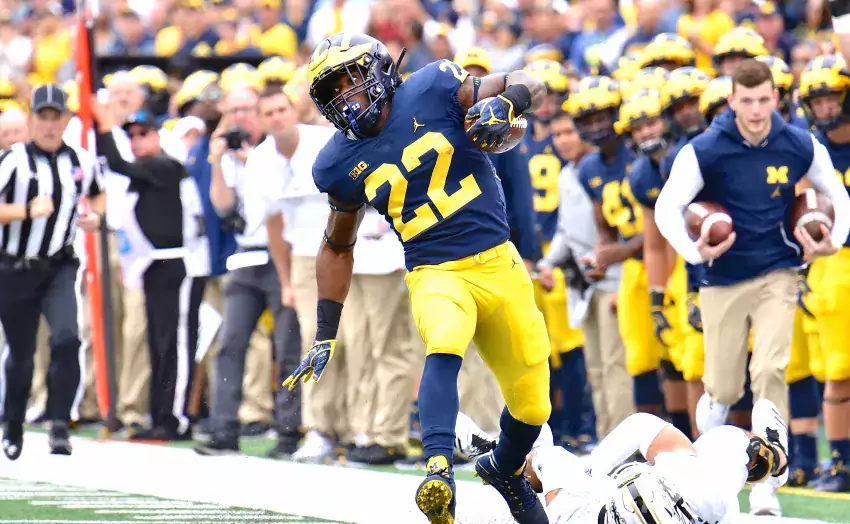
Neck Sharpies: Meet Down G: Half-Power, All-Zone

The result [Fulller]
[Gif is here if you want to go frame-by-frame]
One of the hallmarks of a Harbaugh rushing attack is he finds ways to surprise defenders with blocks they weren't expecting. In the middle of 2016 Michigan brought out a weird play that pulled on the frontside like power but blocked zone on the backside. I started to draw it up, but it never really worked, and it disappeared from the offense until the first quarter of Saturday, when they ran it twice in a row. So let's draw it up.
The play is a meatball gap run where the backside blocks like Outside Zone and the frontside uses a bit of Power. A quick refresher of what that means:
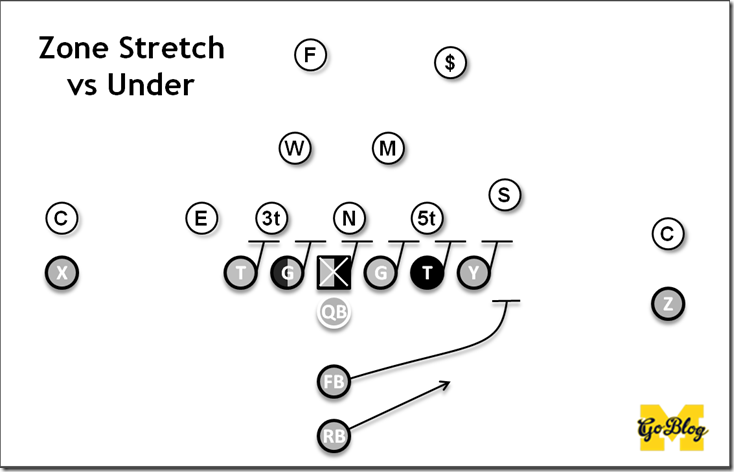
Outside Zone or Zone Stretch: In zone running you block whoever arrives in your gap. Zone stretch is ultra-zone. The line goes sideways, trying to flank the defense, and the back hovers behind this waiting for a defender to make a mistake and give him a lane. For the linemen the rule is if you're "covered," i.e. a lineman is lined up in front of you (even by just a bit), you have to deal with that guy. If you're not covered you can help out your buddy or release downfield and try to get to a linebacker.
A "mistake" for the defensive lineman means giving up a gap, either by getting flanked and sealed, or by "overpursuing," i.e. getting too far outside the lineman so he can push you further that way and create a gap behind him.
Also Outside Zone doesn't block the backside end (Inside Zone does).
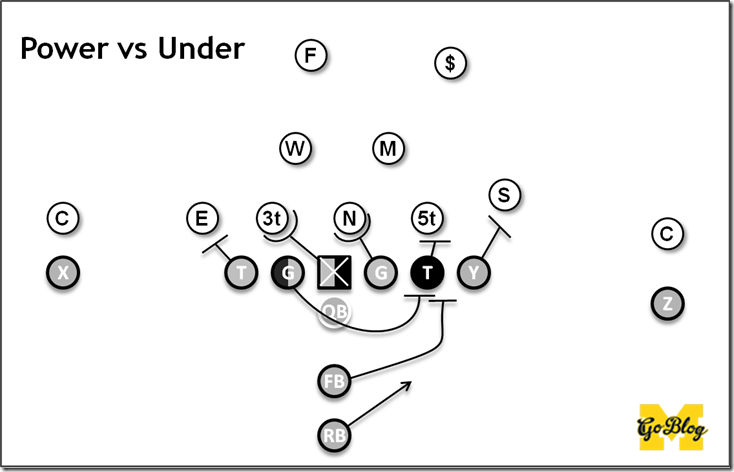
Power (specifically Power G or Power off-tackle): This is God's play. Again, the idea is to flank the defensive linemen, but you're not searching for a hole so much as punching one. You do so by "blocking down" one side of the hole with blockers lined up playside of the defenders they're blocking, and "kicking out" the other side. This creates a guy on the backside who's got nobody to block so he "pulls" to the front and escorts the back through the gap, hopefully getting through there before the backside linebacker can fill. he running back then follows a mass of bodies into the gap.
[After the JUMP: These are entirely different concepts and I don't understand how they can work together]
-----------------------------------------
These are entirely different concepts and I don't understand how they can work together
They are but there are a few things that, in practice, all inside running concepts share:
1. You have to zone a frontside defender if he's lined up in your favorite gap.
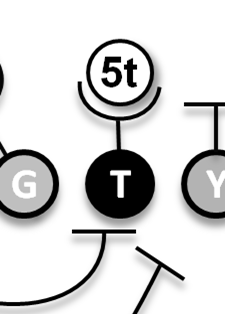
Defenses throughout football history have tried to find ways to get a lineman lined up in the gap offenses most like to run into, and inside running teams often deal with that guy by making him choose a gap and keeping him there. Zone teams might extend this block until the running back is behind it, and then the RB makes that dude commit. Power teams might just blow his ass out, creating room for the RB to go to either side. Either approach can do either thing. Under fronts are supposed to be good at stopping frontside runs inside the tackles because they stick a hefty DT-ish end right where you want to run; win this block consistently and you'll be a nightmare to stop.
2. You have to kick out the force player

The guy at the edge of a defense (the "force player") is going to determine how much space there is to run inside. If that edge defender gets blown out, or thrown way upfield, or buried under a tight end, or sets up way outside because he thinks he's going to be optioned, all the space he just gave up can be used by the offense, which leads to wider gaps for the interior defenders to close down. Michigan's Vipers are excellent at setting this edge, making them hard to run on inside; WMU's OLBs were not particularly good at this and it made life much harder on their teammates. An edge defender too excited to pass rush might completely lose these blocks, but often the edge defender will let himself be sealed in return for setting an edge that doesn't give the inside running game much space.
3. You have to get to the playside LB before he gets to the gap.
That Mike is a pain. Maybe his pass responsibilities will hold him up. Maybe he's slow to process. Often by the time the ball is in the ballcarrier's hands, that guy is on the move, and since he lines up behind a defensive lineman, getting a clear shot on him is hard.
Inside zone and Power, in their most basic forms, have the same answer for the first two blocks: have your right tackle deal with the end, have your tight end kick out the edge, and let whoever's the best at football in those battles determine the size (and location) of the primary gap. Defenders get used to this matchup, expect it, and do their best to keep both sides of the end uninviting, and the edge as closed as possible. As for the Mike, we could spend all day on strategies for getting out to him or stealing a block on him by swapping jobs. In general zone tries to release a lineman on him and power tries to get that puller around in time to take him out, or "cracks" him with a receiver or tight end and uses somebody else to kick out the force player.
So what if you could make sure two of those three blocks were easier?
Swapping Jobs
On this play the backside is blocking like Outside Zone. You can tell because the backside defender is left unblocked, a big No-No if you're running inside since a crashing end would just destroy this in the backfield.
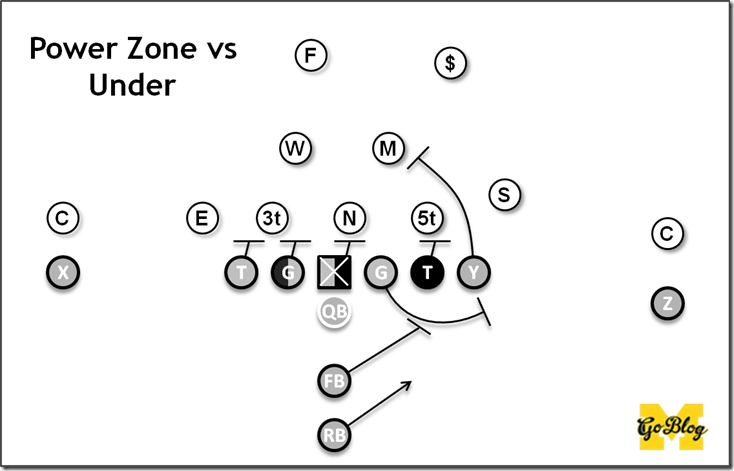
On the frontside it's Inside Zone except the guard and the tight end have essentially swapped jobs. Instead of releasing downfield to attack the linebackers, that guard pulls and executes the kickout block. This frees the tight end to shuffle downfield and wall off the linebacker. That should be easy enough for the tight end—essentially he's acting like an uncovered Inside Zone lineman, and might even offer a chip on the SDE if needed. Meanwhile, a light hybrid SAM in this case has to pause because these days an edge guy not getting blocked has to believe he's about to be optioned. Instead he's met by the pulling right guard. Mass of Onwenu times Acceleration of Onwenu equals the amount of force that's about to jettison him from one side of the intended gap.
However it makes life harder on the center. He doesn't have the benefit of a chip block from the guard anymore. The center has to execute a "Reach Block", meaning he has to get playside of a defensive lineman already shaded to playside. There's a potential here if he doesn't of an unblocked nose tackle flying into the backfield. There's also a potential cutback lane if that happens.
I remember two tight ends though.
Correct, Michigan ran this from a heavy set, though the concept is the same.
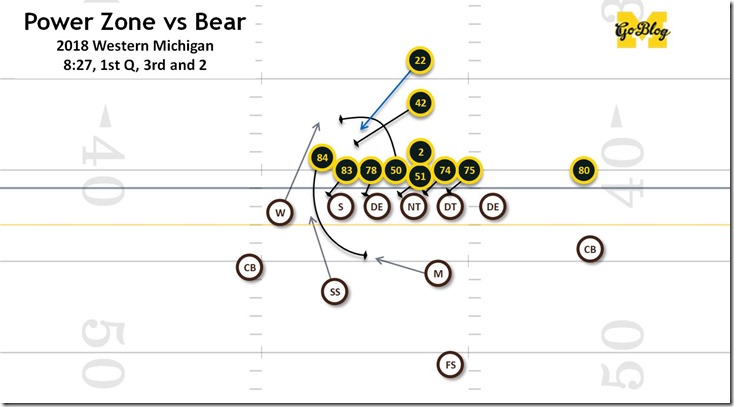
Also WMU, a hyper-aggressive defense known for leaving both safeties at 6 yards on a passing down and blitzing errrrrybody is trying to answer Michigan's heavy set with a "46" or "Bear" defense*

That's fine. The offense can just shift everyone's job over on that side. In fact Michigan invited this by adding an extra tight end to the line over there instead of splitting out a receiver. Block down the SDE like he's a DT on a power play, treat the SAM like the SDE, and kick out the WLB, who's bound to be the guy setting the edge:

The threat of both of those guys as receivers has to put some hesitation in the defense. Gentry's first step is downfield, and that means the safety has to respect the possibility of a TE seam route (he's a WMU safety so he doesn't for long). Ditto the cornerback with McKeon. Keeping those dudes from shooting the gap is critical, and giving them two eligible receivers to worry about is a good way to go about that.
* [Nerds will point out that a true Bear front covers both guards but the DE is off the right tackle's shoulder. This is a customary adjustment when the offense adds an extra TE to the strong side]
Isn't a reach block really difficult? Why are you calling a play that's asks a guy to execute something so difficult?
There are some good reasons.
- Cesar Ruiz is very athletic. Note when they ran it in 2016, Mason Cole was at center. They didn't try it with Patrick Kugler last year.
- WMU was slanting the defensive line a lot, and this is a counter to that slant.
- If the block goes badly, I presume there's a cutback lane available. They are zone blocking after all.
Didn't WMU also go into different gaps?
Yes, they slanted, which means the defensive line all attacked one gap further backside than they were lined up in, and the linebackers in turn will take the abandoned frontside gaps. You can't expect a defense to just tell you what gap they're coming in. WMU was doing a lot of slanting and you almost expect it with a Bear defense because the extra manpower on the frontside leaves you open to backside attacks.
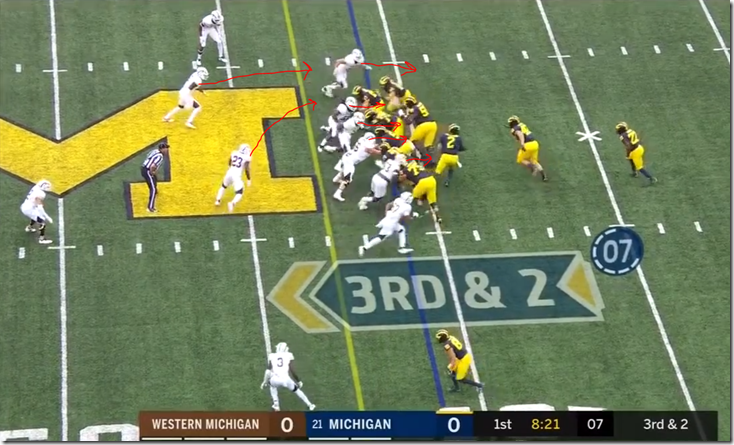
And that's a good thing for this play. Remember those zone blocks on the backside? The slant makes those easier. No NTs roaming into the abandoned gap if the center can't get a reach block. Ruiz's very hard block is now an easy downblock. The tradeoff however is nobody will have a chance to release on the MLB. McKeon is going to have to use himself up on the linebacker. Once the CB and SS realize it's a run play and there's only one gap it can go through they're going to be in it in a hurry.
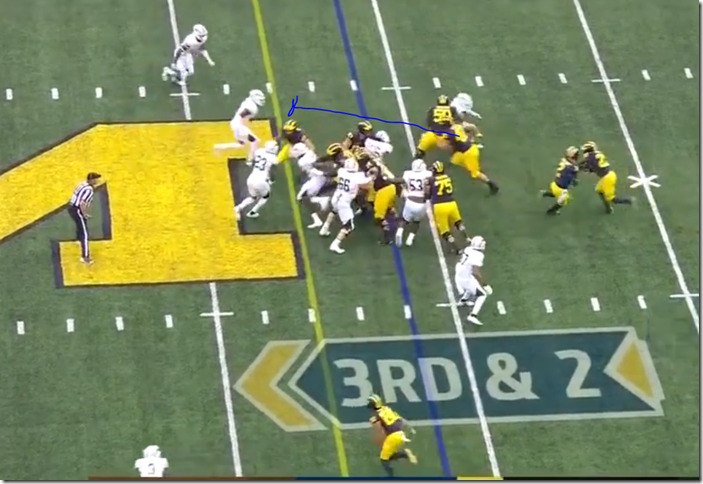
At the handoff the safety has already decided it's a run (or at least that his man, Gentry, isn't going to be blocking). The cornerback is starting to realize it too. This run stuff isn't usually his job, but here is. The offense has a fullback for the safety, but not the corner as well. Also some things are starting to break down for the offense. Juwann Bushell-Beatty's DE (red circle below) has spun off that downblock after giving up some yards, and threatens to get to the gap. McKeon's linebacker (blue) cut upfield and might also slash this down in the backfield. I didn't circle him but Runyan's DT (who lined up playside) has also made it into the backfield. Gentry's LB too has blitzballed upfield, but Gentry has done such a great job in following that guy and keeping him sealed that the dude ends up cut blocking the DT who beat Runyan.
This is the inherent danger of running in tight spaces in such a Baugh way: There are so many things that can go wrong and ruin an otherwise well-blocked play. The tradeoff for that is a thing that goes very right creates an instant traffic jam. Like, for example, BEN MASON CRUMPLING A SAFETY.
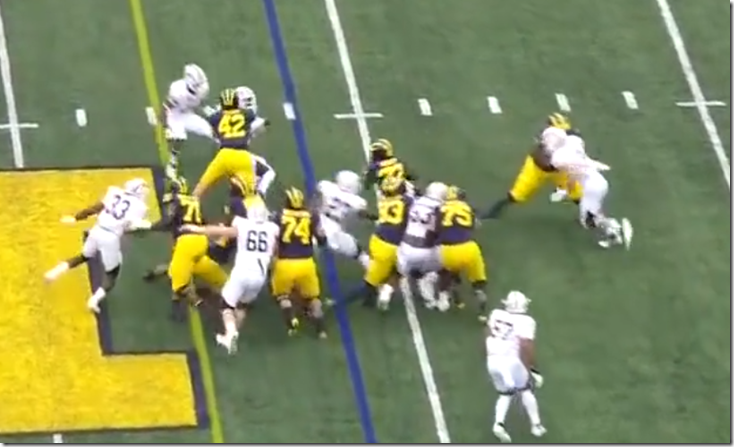
The LB McKeon lost (#23) gets a finger on Higdon as he flings by, uselessly. The DE (#33) who spun off JBB gets his hand on a shoulder. The unblocked cornerback gets the remains of a safety's torso in his lap. Karan is off for his date with the free safety's ankles.
What happened when they tried it again?
The second attempt went to the other side and got zero yards.
What happened? In short WMU adjusted on the fly and Michigan's offense did not. WMU got a chance to sub and went with a true 5-3 package, replacing the useless cornerback with an extra DT. What that buys them is an extra defender willing and able to play a gap. The big thing is this time WMU didn't waste the last guy on the line with setting the edge. The DL again slanted and Bredeson pulled, but this time the DE, Ali Fayad (whom I developed a lot of respect for over the course of the last week) wasn't on contain—he's ready to plug the gap.
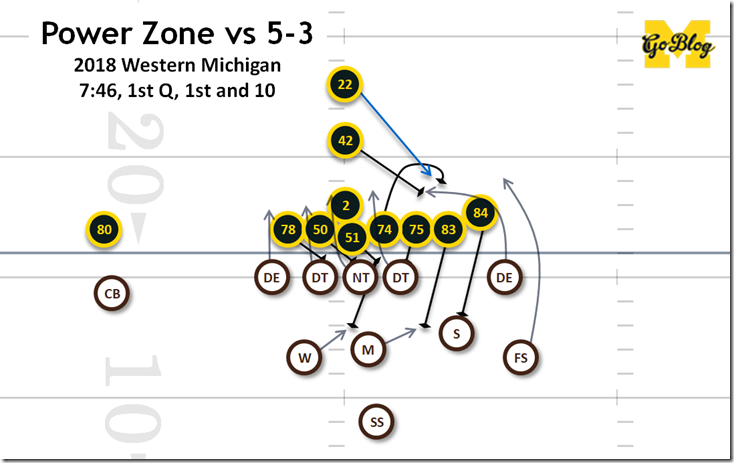
Fayad dove inside Bredeson, who had no choice at that point but to drive the DE and add him to the pile. Watch #57:
The real edge defender is #6, the free safety, who looks like he's lining up as a cornerback (or if we're going back to 5-3 terminology, right halfback) but is actually doing the job of a Viper, i.e. he's got the edge all to himself. Ben Mason isn't expecting this—he fakes like he's getting the handoff then plows fists-first into the hole, which is already claimed for Fayad.
This still could work if Michigan reps it. Bredeson's job is to find the guy with contain and here he got suckered into thinking that was Fayad. Mason's already heading to the gap Fayad is shutting down, and Bredeson, with practice, should know he can pass the DE off and find the REAL edge-setter. With all the other guys sealed inside, Higdon ought to be able to able to follow Bredeson one more gap outside and run off the result of a 320-pound captain versus a very MAC safety.

Alas, Michigan would have to run a play-action (split zone counter) pass the next play for its touchdown. Pfft, passing yards.
Were they done with this then?
Not quite.
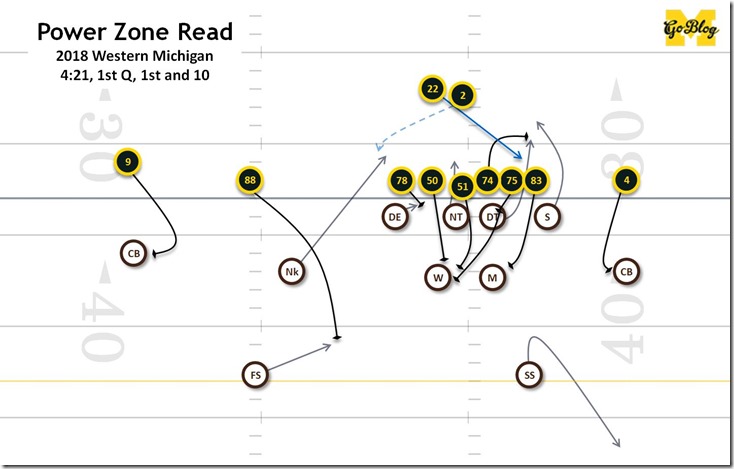
It's hard to see that well because of the zoom but the frontside DT ran himself out to the same edge that the SAM (#7, lined up as a standup DE), so Bredeson just blocked both of them. Ruiz saw the NT (Fayad) going into the backside gap and after enough of a delay, discarded him. Reach block: achieved. Runyan saw the guy he was supposed to block down disappear to an outside gap, which: okay. With Michigan aligned with spread-sized gaps, Onwenu couldn't really do much with Fayad, nor needed to, so he released into the WLB, meeting Runyan there. Gentry stalked the MLB, Ruiz released to escort Higdon down the sideline, and Higdon said "Nah," and outran the Tranquill brother with three ACL surgeries to the endzone.
So does this mean anything except we ate a MAC team alive?
Michigan can run this play as a base concept, since there are ways to deal with the adjustments a defense makes, and some of those adjustments make the defense weaker against other things Michigan is good at, e.g. actual power. It also doesn't rely too heavily on the OTs. The hard jobs instead go to the center, who has to get a reach block executed, and the guards, who have to ID the edge defender quickly out of a pull. That's fine by us, since our tackles are the team's weak spot and the interior OL are at various stages of climbing into good.
I bet you future opponents already planning to attack this by blitzing the gap the guard leaves open, which would require Runyan or JBB to make a play on a linebacker coming inside of them. That opens up the tight end passing game and screens you can run off this same look (let the pulling guard whiff on the edge man then block downfield).
September 12th, 2018 at 1:04 PM ^
That first play is one of the ones I used my 10-second back button on my DVR to watch again, and I was wondering what it was because it didn't look like pin-and-pull to me. This is handy.
It's nice seeing how they run similar plays out of dissimilar formations, and effectively at that. And it's nice to see Bredeson and Onwenu throttling people. We're seeing here that Warinner may have simplified the vocabulary of the line, but they're still doing a lot of fun stuff to mess with the defense in these running plays. I hope that it pays off in big games.
September 12th, 2018 at 1:23 PM ^
A lot of teams tag this scheme out of a pin and pull call if the TE can't reach the DE. That might be what Michigan was doing (though I'm guessing it was a game plan thing based on WMU, and specifically a reaction to how much they struggled getting the edge against Notre Dame)
September 14th, 2018 at 2:05 AM ^
Haha, that's funny...me too. I watched this play so many times on my re-watch. I heard some calling it a zone, but I was like eeeeh, the guard's pulling though...? I ultimately ended up thinking it was just a frontside g-pull. Having read this though, it was definitely a frontside g-pull, but with zone concept as well -- pretty sweet stuff. I love it!
September 12th, 2018 at 1:15 PM ^
Great stuff Comrade -- thanks as always. Gives me optimism that we can scheme around the OT issue in the run game.
September 12th, 2018 at 1:15 PM ^
Were these types of power plays just not effective against ND or did we just not try them?
September 12th, 2018 at 1:35 PM ^
ND had a super athletic DT on the field most of the time. This play does a lot of things to mess with gap responsibility and edge defenders, but all it takes is one or two explosive steps from a DT to wreck this whole thing before it gets started. We will see this in games when coaches are certain that Ruiz can execute that reach block consistently.
Reach blocks are hard enough running outside zone, when the C has the playside G to help him get around the DT. With this play, the playside G is bugging out to the edge, leaving the C to do it on his own. It is not advisable against athletic DTs.
September 12th, 2018 at 1:38 PM ^
This play wasn't run against ND. Harbaugh tends to introduce a new wrinkle or two every week, so that may be the case; skimming through the UFR, Michigan ran inside zone, crackback, power O, pin-and-pull, and maybe one or two other things as well. The power O runs, which generally worked well, faced completely different fronts than this play did, and perhaps that is part of the issue.
September 12th, 2018 at 6:53 PM ^
CORRECTION: Now that UFR is out, I see that Brian labels this play as a "Down G." And Michigan did run at least one of those (I scanned the ND UFR until I found one) last week. As it happens, it was the first-and-goal play on that first field goal drive, the play before the controversial sack. It was run to the left side; according to Brian's grading, Runyan and Gentry blocked well, while Ruiz couldn't get to a LB because the LOS was too crowded. Higdon ran for three yards. Michigan subsequently called a pass and things went poorly.
So this play has been a regular part of the repertoire from the beginning.
September 12th, 2018 at 1:16 PM ^
Love this level of analysis. Thanks, Seth!
September 12th, 2018 at 1:25 PM ^
I am now smarter for having read this. Thank you.
September 12th, 2018 at 1:26 PM ^
I was a little bamboozled by the Power Zone Read play when I watched it live. As you said, the camera angle and the speed that Ruiz releases to the 2nd level originally made me think that it was Ruiz who was pulling. When I finally realized it was the front side guard I was again surprised as I don't really recall seeing that in the past.
This is a cool wrinkle that allows Michigan to plan around our current weakness and gives me even more confidence that the coaching staff can help account for some of the areas where personnel is deficient.
Thinking about the infamous double A gap blitz against this kind of scheme does give me pause for concern though. MSU's hyperactive blitzing linebackers tend to sniff this kind of stuff out and I can see a time or two of Higdon scraping himself off the turf after Joe Bachie cuts through the abandoned Guard gap.
September 12th, 2018 at 1:33 PM ^
This is good shit here. Spent my lunch break reading this. Excellent!
September 12th, 2018 at 1:54 PM ^
The double A gap twist blitz is a terrific play because it's a challenge to defend; it's also part of the chess match. Michigan knows it will come. If, for some reason, MSU were to load the line like WMU and still bring the twist blitz (I doubt it will come out of that look, but I haven't actually watched MSU closely enough to see how they deploy it to that detail) they risk clogging the middle while Michigan is exploiting them on the edge, or getting burned when a TE like Gentry slips past his man and goes downfield for a wide-open route on PA.
I don't really know enough to know how all that will work together; but the coaches know it's coming, and they'll prepare both the line to adjust its blocks and plays to counter.
Making it work is a different story.
September 12th, 2018 at 1:38 PM ^
This is great content.
I haven't watched a replay of the game, but is Gentry becoming a plus blocker? Last year he was able to mostly get in the way, but he's worked his way to legitimate tight end size (from 215 to 262). Not sure his success will last against beefier non-MAC teams but definitely impressed with his development.
September 12th, 2018 at 1:43 PM ^
I think it's TBD. There are times he does well. He also got wrecked in pass pro against ND. He's a TE, so it's not like we need him to be Jake Long; if he regularly makes good blocks, especially in run-blocking, he's a nightmare matchup for opponents.
Honestly I'm more concerned about his receiving right now. He was supposed to be an unstoppable threat, and so far there hasn't been much there. Hopefully the passing game will continue to emerge and he'll be a big part of that.
September 12th, 2018 at 1:52 PM ^
This is an interesting point. Michigan did all sorts of "interesting" things with the TE position when we had Jake Butt. Screen game, seam routes etc... Michigan has shown a lot of underneath and crossing routes with the TEs so far and while it obviously paid off last week in McKeon's TD, I think there is still room to further exploit smaller DBs against these mansome TEs.
Part of that is probably predicated on M's desire to run more shotgun spreadout looks that maybe rely less on TEs? I could be wrong about that though. I haven't gone back and reviewed personnel groupings from the last 2 weeks.
September 12th, 2018 at 1:55 PM ^
We've still got a TE or two on the field almost all of the time, even from spread looks. TEs are tough matchups for the defense, and Gentry and Mckeon provide a lot of package flexibility for formations and blocking schemes.
September 12th, 2018 at 2:20 PM ^
This is also a set up to run influence wham/trap if they so desire, because it gets the D attempting to attack the gap vacated by the pulling FSG, and the 2nd/3rd level filling the C gap run lane, which opens up the straight ahead run scheme
September 12th, 2018 at 2:30 PM ^
This blocking scheme from the gun is going to set up the RPO package. The OG pulls but Y goes up the seam instead of blocking down on the LB. If the LB stays with Y up the seam, the hand-off occurs because the LB is essentially "blocked" for the run option. But if the LB crashes the gap as Seth indicates, then Shea reads pass and hits Y up the seam for a big gainer.
I think we torch Nebraska with that gem in the B1G opener.
Trust Harbaugh ... there is a plan ... "I can feel it coming in the air tonight, oh Lord" (PC)
Go Blue !!!
September 12th, 2018 at 2:47 PM ^
Do you like Phil Collins? His solo career seems to be more commercial and therefore more satisfying, in a narrower way. Especially songs like 'In the Air Tonight' and 'Against All Odds.' But I also think Phil Collins works best within the confines of the group, than as a solo artist. And I stress the word 'artist.' Let's listen to Sussudio, a great, great song. A personal favorite.
September 12th, 2018 at 3:01 PM ^
Yes, and a very good observation on his career. The song choice really just felt appropriate for my believe in how this season will unfold. There could be others who have their own ideas ...
September 13th, 2018 at 9:01 AM ^
It was a reference ;) No, I wasn't the one who downvoted you though.
September 12th, 2018 at 3:10 PM ^
This may set up a pop pass PAP, but I’m doubtful it will set up an RPO. A few reasons
1) The RPOs we’ve seen to date are extremely simple reads. This would be an expensive read because it isn’t only the LB you’re concerned with, you also need to check the safety coming over the top
2) With this concept, it’s a quick hitting play. This means the mesh is relatively short and doesn’t provide much time for the play to develop and make a read. I could see a read of the backside DE, but the complexity of the read you’re talking about takes more time
3) Even OU, which runs a ton of RPO, does not RPO their Counter GT scheme. That’s a longer developing concept, but even then they feel the read is too expensive to get correct consistently. Typically for a playside pop pass RPO you need your receiver to gain some width to make the read clearer, and that isn’t the TE’s path here.
4) Given Harbaugh’s history, he’s going to run the run concept correctly, and not sacrifice it for a read. It’s not that he doesn’t run RPO, but if baseline is give he’s making sure it’s blocked up
September 12th, 2018 at 3:07 PM ^
Obviously Michigan isn't a no huddle team, but I wonder if it's within the scheme/terminology/scope of the offense to give Shea run checks based off of the defense's alignment. For instance, if the defense seems to be cheating to one blocking scheme to have an audible to switch it up.
September 12th, 2018 at 3:11 PM ^
He “killed” a play that JBB false started on. So there are instances he is given multiple plays and the ability to check out based on D look.
September 12th, 2018 at 3:59 PM ^
This is a great article. Along the spectrum of football knowledge, I'm something like a 2.5/10 and this sort of breakdown reminds me that there's always a bigger fish. Thanks for the enjoyable and (for me) educational content.
September 12th, 2018 at 4:30 PM ^
So, if this shows creativity in the blocking scheme, introducing a new wrinkle in the way the Oline attacks the LOS, why does this get graded as a great playcall opposed to the same kind of plays that were called against the Irish? The answer, of course, is that because they were well-blocked by everyone, an explosive play resulted.
But isn't this always the case in assessing whether the play-calling was effective or not week to week, because the play execution actually made the play successful when called?
If somebody fails an assignment or doesn't execute properly, the play breaks down on some level.
Last week, Michigan ran off tackle and creases were created but Higdon exasperatingly failed to exploit them in an explosive way. You can go through that game and find instances where he gets tripped up after getting through the LOS clean and a linebacker or safety manages to trip him up as he was tackled on that long run against Western diagnosed here. Everyone must execute for a play to really work regardless of the competition.
And that goes to executing fundamentals and assignments, not playcalling, because in the end, Michigan didn't do anything exotic against Western than they did against ND, largely because they had a 100 pound advantage per man at the LOS.
September 12th, 2018 at 11:20 PM ^
I read a blog a few years back about this play. I found it again here:
That blog called the play “down G”. Perhaps that reference may be helpful to someone.
Edit: I see Brian in the ufr and stevenrjking above have already referred to the play as “down g”
September 13th, 2018 at 9:03 AM ^
From your post it doesn't sound like you know but Space Coyote here is that blog's author.
September 13th, 2018 at 2:59 PM ^
This is an old Joe Gibbs play I think. Always got time for some Hog football.
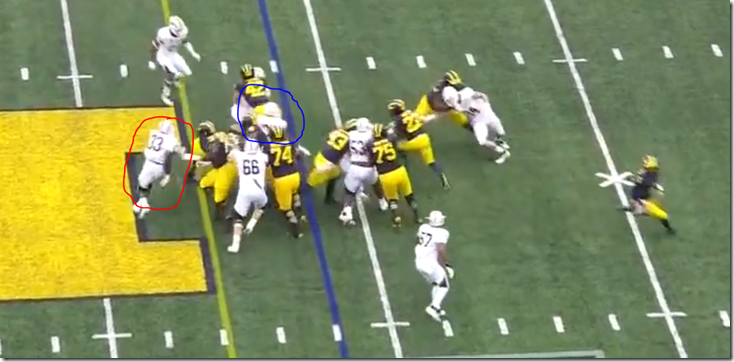
Comments